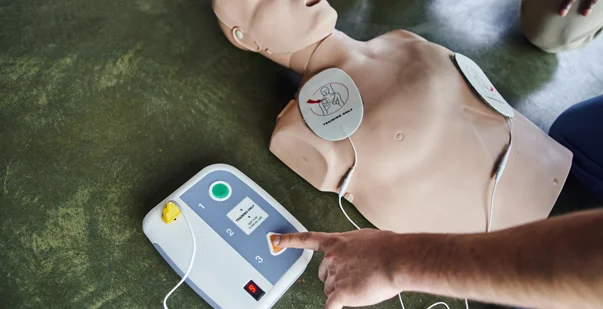
Last Updated on: August 1, 2024
An AED, or Automated External Defibrillator, is a device that can save lives. It’s used when someone’s heart stops beating normally. Did you know? AEDs can increase survival rates from sudden cardiac arrest by up to 70% when used quickly. A good CPR training class can train you on AED use. Read on to learn all about AEDs and how you use an AED.
An AED is a portable device that checks the heart rhythm. These are used to deliver an electric shock to the victim’s heart in cardiac emergencies. AEDs are easy to use, even for people with no medical training.
In case of emergencies, you can avail it from public places like gyms, malls, and airports. AEDs are safe to use – they won’t shock someone unless they need it. Modern AEDs give voice instructions to guide you through each step. Using an AED along with CPR gives the best chance of survival. For every minute without CPR and defibrillation, the chance of survival goes down by 7-10%.
You should use an AED when you find someone who is not responding when you talk to them or touch them, is not breathing normally, and has no signs of life (not moving, not coughing). These signs usually mean the person’s heart has stopped beating properly. Quick action with an AED can be the difference between life and death.
There are a few steps to follow in an AED use. The proper steps for operating an AED are:
Step 1: Examine the victim
Step 2: Turn on the AED
Step 3: Bare the chest
Step 4: Apply the pads
Step 5: Plug in the connector (if needed)
Step 6: Stand clear
Step 7: Let the AED analyze
Step 8: Deliver a shock if advised
Step 9: Start CPR
Step 10: Follow the AED instructions or prompts.
Read More: When To Stop Performing CPR?
Sometimes, you might face special situations during an AED use. Here’s what to do:
Water: If the person is wet, quickly dry their chest before applying pads. Move the person away from puddles or standing water.
Medication Patches: Remove any visible patches from the chest before applying AED pads. Don’t place AED pads directly on top of medication patches.
Pacemakers or Implanted Devices: If you see a raised bump or scar on the chest, place the pad about 1 inch away from it.
Children: Sometimes, child pads are available for use on children younger than age eight. But in case the children’s pads are not available, the pads meant for adults can also be used.
Just using the AED may not be enough to save a victim’s life. After you’ve used an AED:
If you own an AED or are responsible for the maintenance of an AED, these are the things you should keep in mind-
Check the AED regularly (at least once a month) to make sure it’s working.
While AEDs are made to be easy to use, getting trained can make you more confident and effective. Here’s why AED training is important:
Read More: The Main Objectives and Goals of First Aid Training
AEDs are becoming more common in public places. This is great news because it means help is often nearby when someone needs it. They’re usually in visible locations and marked with a heart symbol. Knowing where AEDs are located can save precious time in an emergency. Here are some places where you might find an AED:
Using an AED might seem scary, but it’s actually quite simple. These devices are made to be used by anyone, even without training. By understanding how to use an AED, you’re better prepared to help in a life-threatening situation. The more people who know how to use an AED, the more lives we can save together.